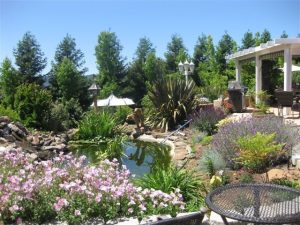Our sizzling, record-setting summer days are a dramatic example of the ever-changing environment just outside our windows. Searing heat and desiccating drought, unseasonal chill, and powerful storms—we Foothill gardeners are all too familiar with erratic weather.
A climate-friendly garden releases less heat-trapping gases and stores more. Wisely selecting the plants, you grow and adapting the way you grow them helps do that.
Grow the Right Stuff
Grow natives suited to your area as natives are often more drought tolerant, disease resistant and better help sustain imperiled wildlife. Be sure to diversify your plantings to increase chances of survival as the climate shifts.
Long-lived shrubs and trees store their carbon for extended periods. Some trees, such as native oaks, can live for centuries while providing wildlife homes and food. Dead trees and rotting wood release carbon back into the air. To learn more check out this article.
Coddling turf grass with generous amounts water, fertilizer and herbicides can trigger release of carbon and nitrous oxide (a heat-trapping gas many times more potent than carbon dioxide). Instead grow drought-tolerant grasses or native ground covers, shrubs and meadows. To better manage an existing lawn, leave grass clippings to decompose and nourish the grass; water deeply but less frequently to encourage deep rooting; and invest in an emissions-free, calorie-burning push mower. Power equipment burns fossil fuels and releases large amounts of heat-trapping gases, so use hand equipment whenever feasible.
Much of our supermarket produce is grown with large amounts of fertilizers, pesticides and water, and is shipped more than 1500 miles, often in refrigerated trucks. Growing your own food will be energy-conserving, fresher, tastier and more nutritious.
Grow the Climate-Friendly Way
Excess nitrogen from fertilizer runs into and sickens our creeks, rivers, and groundwater. Some is converted to nitrous oxide. Synthetic fertilizers, especially the nitrogen-based ones, require large amounts of energy and create carbon in their manufacture, packaging, and transport. Supply slow-release plant nutrients instead with compost or other organic mulches, or apply modest amounts of slow-release fertilizer which is less likely to leach into waterways.
Pesticide production contributes to carbon release; weed killers (herbicides) especially generate more carbon emissions. Mulch, mulch, mulch, to reduce the need for herbicides. Use Integrated Pest Management methods to manage both weeds and insects as detailed here.
Create your own compost and mulch with grass and yard trimmings, barnyard manure, and kitchen waste. These organic materials make up about one quarter of our municipal solid waste.
When disposed of in landfills, some of the waste breaks down releasing methane, another potent heat-trapping gas.
Soil can be a powerful place in which to store (sequester) carbon. Bare soil is vulnerable to erosion which triggers release of the soil’s carbon. Overly tilled soil also results in carbon loss. Top unused soil with mulch, cover crops, or even non-invasive weeds to help support soil organisms and provide food and cover for wildlife. Scientists are researching more soil management techniques to conserve and store carbon as detailed here.
The number one use of energy in California is pumping and moving water, about half of which is used outside our homes. Shrink water consumption by growing drought-resistant plant species, mulch, use drip irrigation and eliminate runoff.
Sonora gardener, Vera Strader, eliminated her lawn to do away with water and crabgrass woes.
Vera is a University of California Cooperative Extension Master Gardener of Tuolumne County.
UCCE Master Gardeners of Tuolumne and Calaveras Counties can answer home gardening questions. Call 209-533-5912 or fill out our easy-to-use problem questionnaire here. Check out our website here. You can also find us on Facebook.

